THE LOST COAST OF GABON
WEST AFRICA
Accompanied by photographer Peter McBride and two Gabonese eco-guides, we made an exhausting and exhilarating circumnavigation of Gabon’s jewel of a national park, Loango. Bordered by the Atlantic Ocean and stretching 40 miles into the jungled-interior, we kayaked and portaged More than 200 miles around the park’s perimeter, seeing this wild country from a new and different perspective.
THE LOST COAST OF GABON
I
t had been a long, hot day paddling sea kayaks on the Atlantic Ocean, paralleling the coast of the small West African nation of Gabon, smack on the equator. Eight hours on a hard plastic seat, sometimes as much as three miles offshore, on rolling, mostly calm seas. We were looking forward to surfing the heavily loaded plastic boats into shore, to stretch legs and every other imaginable body part.
Yet at day’s end we found ourselves happily sitting in the surf zone, back paddling against big rolling waves attempting to push us towards the white sand beach known as Petit Loango. What kept us at sea? A Noah’s Ark of big animals emerging from the forest onto the shore right in front of us. As sizable tarpons exposed silver underbellies next to us, big, brown forest elephants emerged to munch on the sandy grass. A family of buffaloes ruminated not far from where dwarf crocodiles sunned themselves in the nearby lagoon. And then the Holy Grail – surfing hippos – emerged, a trio of them, readying for an end of the afternoon swim. Our welcoming party!
It was difficult to make a move towards shore, for fear we’d spook the big beasts. “I’ve never seen anything like this from the seat of a kayak,” says my partner in this adventure, Michael Fay. That’s saying a lot, since a few years back the American biologist and environmental activist walked 456 straight days across the Congo forest to document its biodiversity and draw attention to its vulnerability, ending his journey near this very beach.
We tread water for an hour before surfing into the wide beach. While we linger in the setting sun I ask Mike if this spot has a name. “Well, sometimes we call it Hippo Camp, for the big guys who surf here. Or Croc Camp, nothing formal. Why, do you have an idea?”
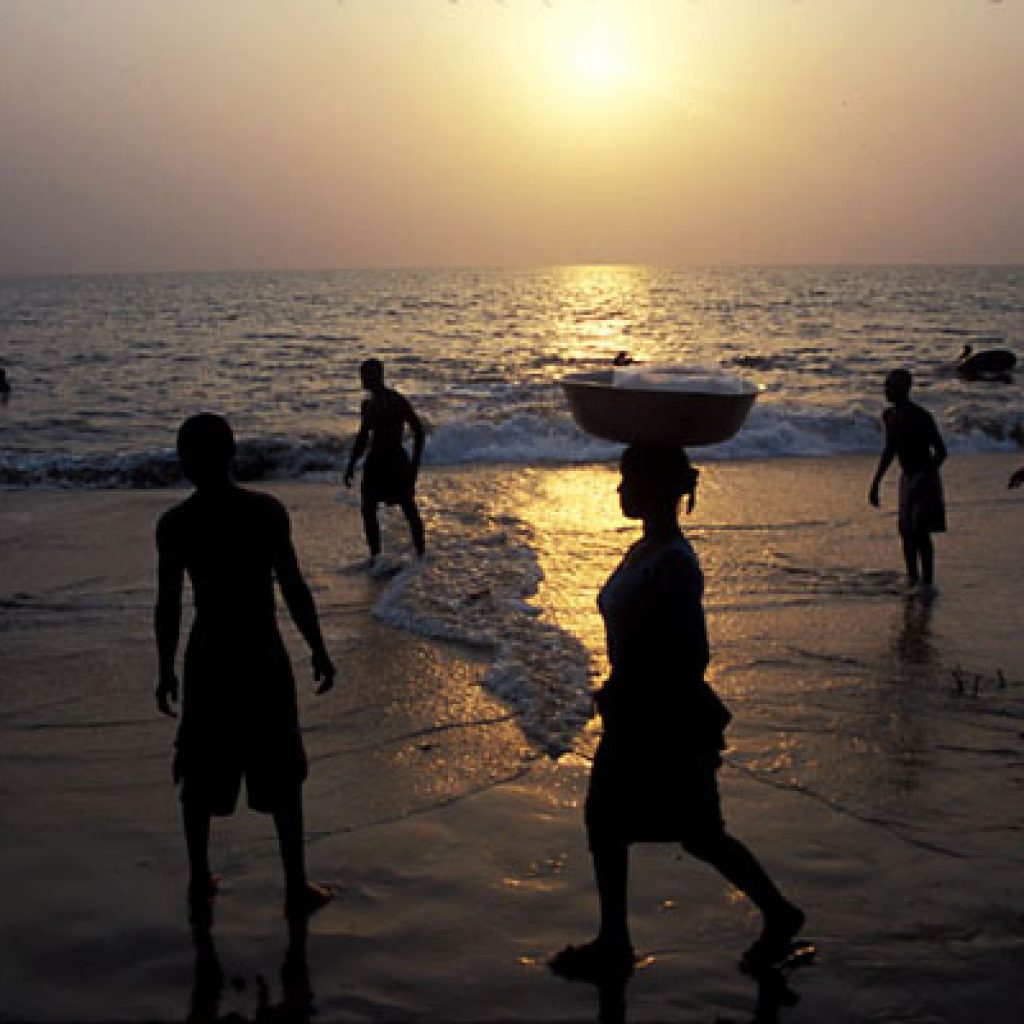
I kind of prefer Baobab Camp, since we are standing beneath the only such tree – the infamous “upside down” tree famous in other parts Africa but rare here – on the coastal border of Gabon’s first national Park, called Loango. The 100-foot-tall tree was most likely planted by a slave merchant 200 to 300 years ago when this coast was amok with traders.
During the past 40 years, the economy of this sparsely populated country – just 1 million people — has been predominately oil and timber. Ecotourism is just starting to make inroads as a potential new economy. It was jump-started just a year and a half before when this beach and the dense forest that stretches inland for dozens of miles were protected – along with 12 other national parks, a total of 11 percent of Gabon – thanks to one monumental presidential signature.
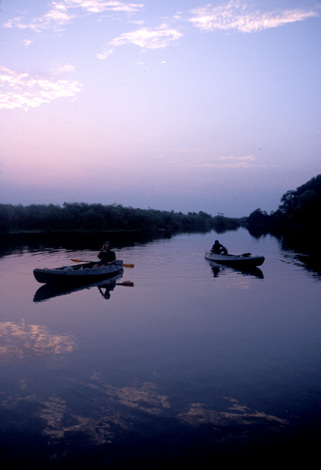
We’d been on the ocean for just a couple days; the previous two weeks in early February had been spent paddling across inland lakes and up a long river, and then pulling the kayaks on wheels on an overgrown jungle trail to the ocean. Our goal was a 120-mile circumnavigation of Loango, the country’s jewel of a national park.
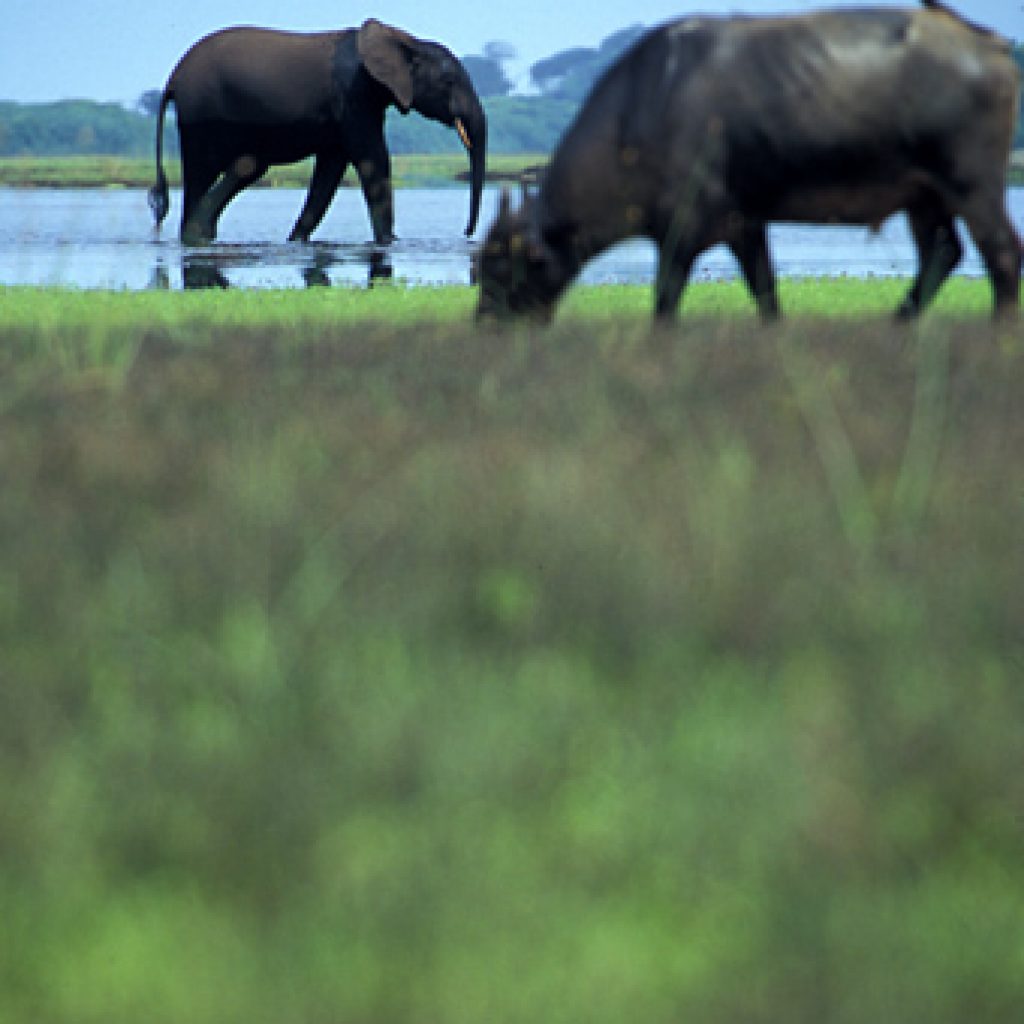
In August 2002 – thanks to long and impressive efforts by a variety of international environmental groups and prompted by a series of beautiful photographs and video of his country’s little-seen interior – President Omar Bongo had proclaimed 13 national parks in the country he’d presided over for 36 years. There had been none before. Today the 13 parks are scattered across the country, forever out of the sites of always-eager oil and logging companies looking for new lands to exploit. Bongo’s decision was perhaps the biggest conservation sign-over in history and Mike had been a big part of the push.
“It’s an unprecedented move,” says Mike about the president’s declaration. “You have to go back to guys like Teddy Roosevelt and his creation of 230 million acres of national forest in the U.S., which was similarly radical and the result very positive.”
“It is not an easy country to start-up eco-tourism, but Loango happens to be an extremely beautiful place. Great climate, few bugs, hippos and elephants on the beach. What we’re trying to do now is show the government in a very clear and real way how you can mix the public sector with the private to create a sustainable management structure for all the national parks. We’ve still got lots of things to do – more beach clean up, trawler control. But while there are still obstacles, I don’t focus on the frustrations.”
Since Mike had already walked across the country, we decided to see some of it from the seat of a kayak. We were five. Since 1999 I’ve organized sea kayak expeditions around the world, for both adventure and to learn about the lives of people who live on or near the sea, and the environments of the oceans. Photographer Pete McBride has joined me on several of those adventures. California-born Fay has lived and worked in Africa for 25 years; the great thing about our foray is that he’ll be going places, seeing things he’s never seen before. We are joined by two young Gabonese – Sophiano Etouck, 30, and Aime Jessy, 22 – who are in training to become eco-guides at the brand new park.
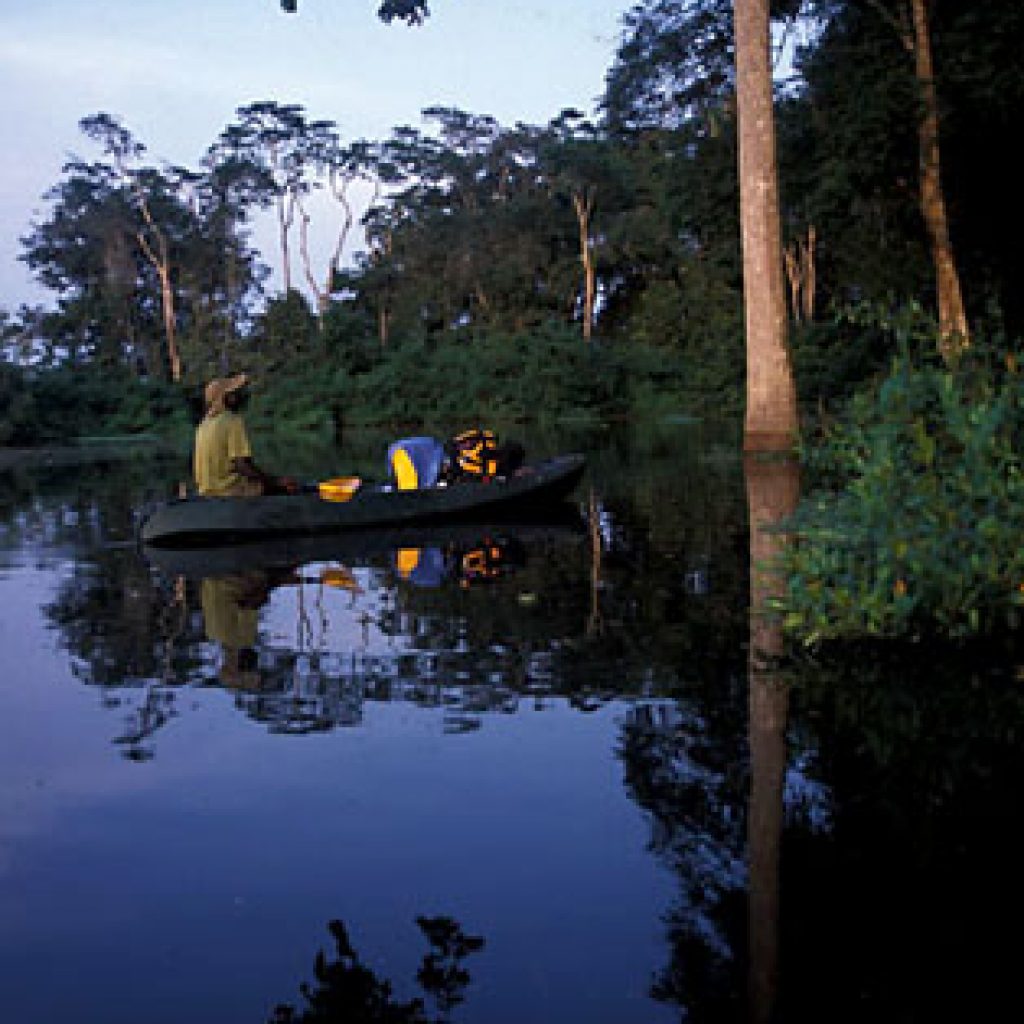
s we ready the kayaks at Loango’s first-and-only lodge – Iguela, an amazingly sophisticated African safari camp, built on the lagoon four miles from the sea, in full operation for less than six months but already booming – Fay is full of questions. For me: “How familiar are you with tsetse flies?” For Sophiano and Aime: “Are you sure you guys can swim?”
We push off under sultry, gray skies (no big surprise since two out of three days in Gabon are gray), and no sight of those four-meter-long crocodiles that have discouraged us from taking much-needed and desired swims in the lagoon. We will cut across the 120-square-mile N’goya lagoon before heading 25 miles up the N’Gove River. It is the rainy season, and the dense black and red mangrove forests that line the shores are flooded by high water.
It is wild country. The Congo basin rainforest is the second largest rainforest expanse in the world; 77 percent of Gabon is covered by dense, hilly forest. The country offers a rare interface between terrestrial and marine wilderness, wild ocean, lagoons and river mouths. There are 50,000 to 60,000 elephants in Gabon, many the coastal species, thus smaller, making it easier for them to crash through the thick foliage. The forests are also filled with bush pigs and lowland gorillas, sitatongas and buffalo. Along its 540 miles of ocean coast are an abundance of Atlantic sea turtles, dolphins, whales and fish. Birds are in every tree, from kingfishers and turacos, to 26 types of bee-eaters and grey parrots (the national symbol, white and gray with a red tail).
This first day we cross the wide lagoon, mostly hugging the forested shoreline. A mist rises above the tall Okume trees, branches laden with squawking monkeys.
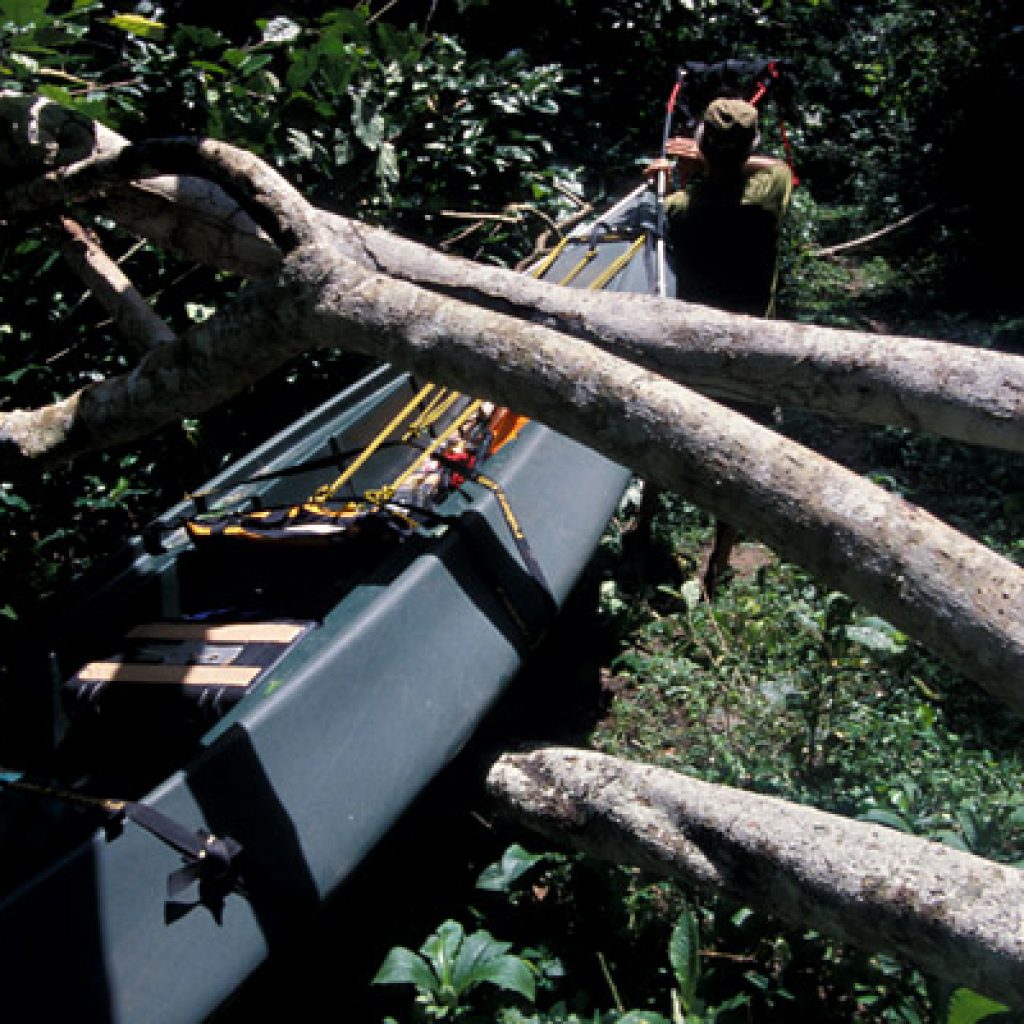
Roughly 400 people live around the lagoon, mostly fisherman, and at day’s end we pull into the camp of the local chief, who invites us to stay the night and offers us pine nuts, pineapple and breadfruit. We trade him a newly sharpened machete for a dull, broken model. He is the chief of approximately 1,000 people and his region is rich with oil. He guesses that over the year’s oil companies have taken $25 billion from the area. The locals take? $0. Bone thin at 78, wearing only a pair of cut off khakis, he is accepting of that status quo, rather than angered. To the chief, the national parks are a good thing, largely because they will employ many of his neighbors.
Before sunset he proudly takes us to visit a valuable icon kept in a kind of shrine, a three-sided shack partially covered by a rusting corrugated metal roof. On a rotting wooden table under the protection lies a piece of iron found in the stomach of a dead elephant more than 100 years before. He tells us that the piece of metal grows every year, especially when a woman in the community is pregnant.
“The interesting thing,” whispers Fay, out of earshot of the chief, “is that they have never doubted that it is true. It is just fact.”
Our upriver paddle begins the next afternoon, at the swollen mouth of the N’gove. We’ll be paddling against strong currents and curves for 25 miles . . . which makes me wonder, Whose idea was this anyway?
Paddling into a light wind and rain we stick to the shores, hugging the blooming papyrus and palms. The flooded forests on either side are haunting — dark, wet and humid, filled with leeches and shoe-sucking mud. Three feet of river water rises up the thick trunks of tall trees. During the dry season the thick papyrus – a favored elephant snack — runs right down to the river, turning the shores into “a kind of Serengeti,” says Mike, heavy with hungry elephants.
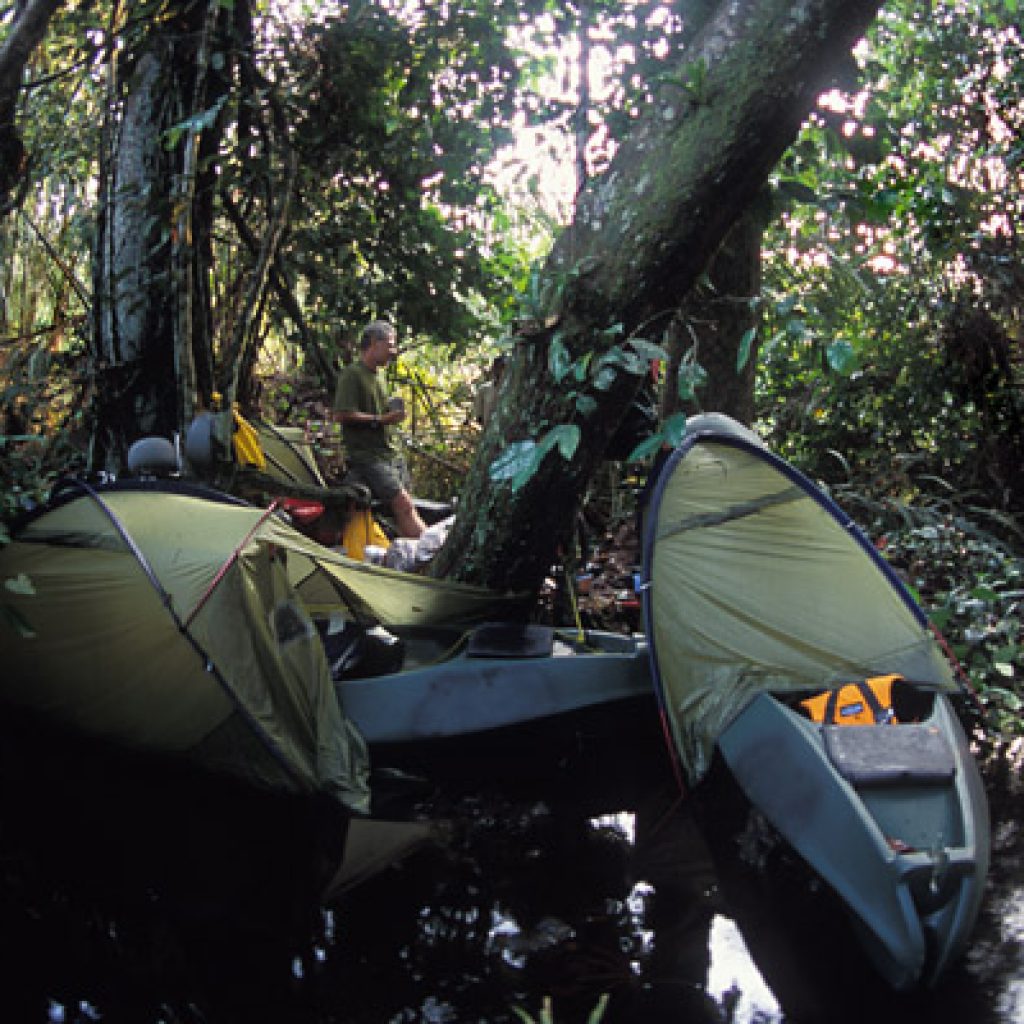
ate in the afternoon it’s as if the animals woke up. An elephant swims across the river 30 yards ahead of us; a river tarpon raises midstream; buffaloes paralleling the river crash through the muck, followed by a beautifully white-striped sitatunga. Pete and Mike paddle into the flooded forest and a manatee jumps between them. At sunset, a flock of egrets rises from an acacia, hippos and male gorillas bark. “I’ve never seen a manatees like that,” says Mike, truly impressed. “And I’ve never seen a river tarpon during this season. We thought they were only up here during the dry season.”
The river braids as we climb, forcing us to choose one channel over another several times. We mostly make the right choice. One very important observation we are each making is that as dusk closes in it is clear there is very little terra firma nearby. We’ll have to stop and sleep somewhere, but solid ground may still be many hours upriver.
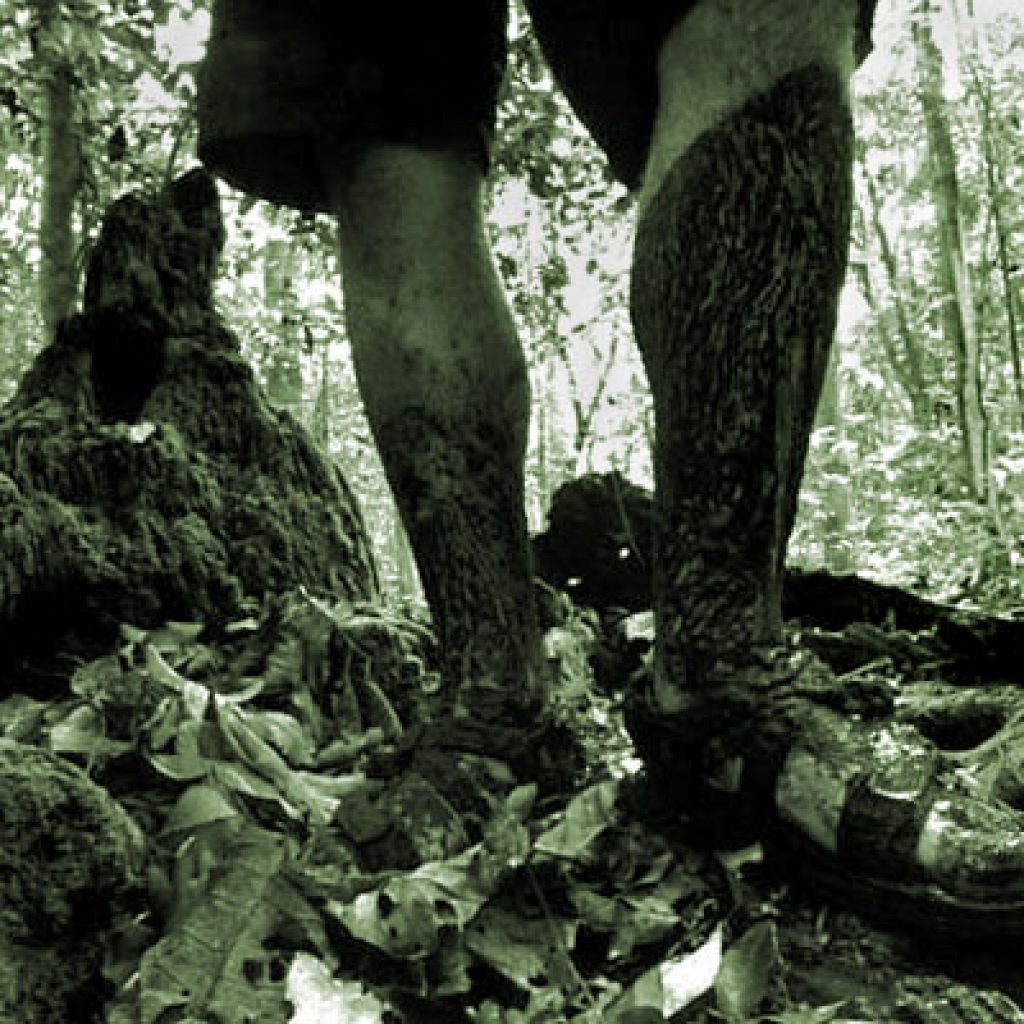
Around 5 p.m., with just an hour of light left and big rainstorms threatening, it is clear that we are not going to find land anytime soon. Mike and I confer mid-river.
“The only thing to do is paddle into the flooded forest, tie up to some trees, put our tents on top of the boats, and voila!” I suggest. Without debate the decision is made – to sleep in our kayaks – because, well, because there’s no option.
We paddle into the dark forest, bumping into hanging vines and branches, looking for a small tuft of muck we can pull the bows of the kayaks onto, maybe something sturdy enough for us to stand on, set up a stove and start cooking dinner before what will assuredly be heavy rains arrive.
Suitable muck is found at the base of a giant okume and we pull the bows of three boats up into the mud and empty them of dry bags, portage carts, paddles, Pelican cases, tying everything to nearby trees, just in case the river should rise with the coming rains. Our tents set up atop the kayaks should be sufficient to keep us dry; Sophiano and Aime are in a bit of a fix, since they opted to bring just one tent to share. Which means they’ll spend this night uncomfortably squeezed into a single kayak.
We light the stoves just as it begins to rain heavily. Mike has found a huge branch to sit on, and a tiny, folding umbrella; I hunker down on the nose of my kayak snug under a rain jacket hood; Pete is still trying to drain his boat of river water; Sophiano and Aime have set their kayaks up side by side in the middle of the flooded forest. The rain makes quick work of our fire, so dinner is scratched and we crawl into our tent/boats. It is only 7 p.m. And then it begins to rain for real, the dark, fairy-tale-like forest lit up by lightning and long peels of rolling thunder, making for a long night filled with worries of rising waters and falling trees . . .. Despite all that, I sleep like a baby.
e start the next morning early, just after five a.m., hoping to spy the same abundance of wildlife we’d caught at day’s end. Which paid off. Paddling in the dark, following an unknown braid of the oxtail of the northern river, we sat beneath a tree mid-river filled with 200 white egrets, playing an hour-long game of flying out and returning, a beautiful sight as the big flock of birds comes and goes against the just-sunlit sky.
From the tree to the head of the 13-mile trail that we’ll pull the kayaks over is less than an hour’s paddle. It is an old “colonial” trail, built by early explorers as a link between inland lagoons. Its condition is unknown – it’s possible we’ll find it impassable, a mud fest, or blocked by numerous, elephant-downed trees, meaning we may have to return the way we came.
Kayaks and gear gingerly rigged atop portage carts and pulled by harness like a dogsled, within the first 100 feet we run across sizable gorilla scat, three-foot wide elephant footprints in the mud and seven-inch, red-and-black African worms curled in the middle of the trail. If we thought it was hot on the river, now we’re under a jungle canopy, pulling 150-200 pound loads over a very, very rough trail. Nearing heat stroke, we suck down water from dromedary bags. Our biggest concern is the big, bulbous tires on the portage carts. If they start to fail – go flat – we’re going to be in big trouble.
Carrying machetes to hack at tree limbs and branches covering the path, we cross beautiful, clear streams and old overgrown bridges made from downed logs. Stopping is risky, thanks to long lines of red ants, the kind that take a piece of flesh when they bite.
By five o’clock, even Mike – who one men’s magazine recently included on a list of the world’s “25 Toughest Men” — is too tired to move. “I could just fall down right here, “ he admits, in the middle of the trail. Though we are now only 60 miles from his base, he also admits – happily – that we are once again in a place he’s never been before.
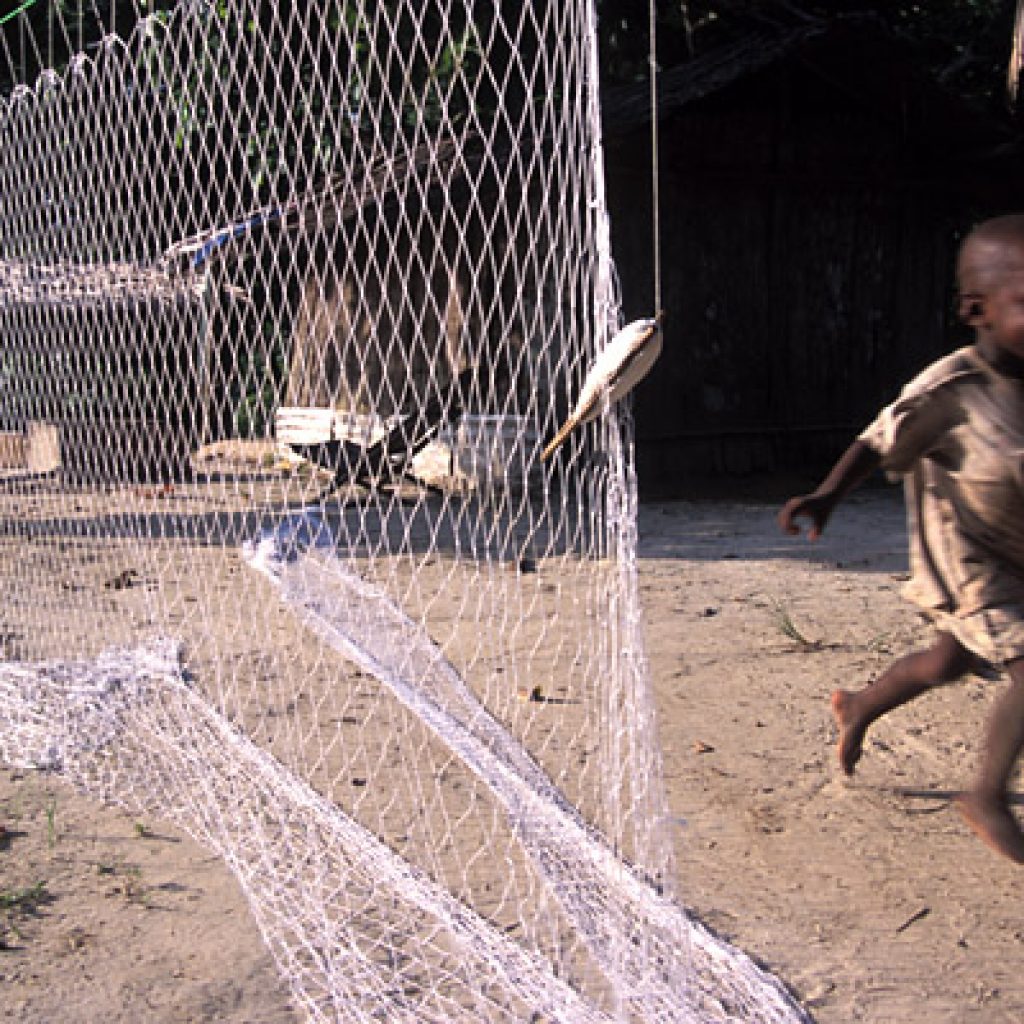
Best sign of the day? We can hear the ocean, seven miles away as the crow flies, through the jungle.
The next morning is spent repairing tires. All ten of them, thanks to run-ins with long macaranga and fagara spikes. Melting rubber over our cook stoves and applying it to holes identified by immersing the tires in a nearby stream proves ineffectual. For the next two days we’ll be pulling the boats on nearly flat tires. “It’s like the parking brake is on,” says Pete as we set off. When we finally drag the boats into the village at Souanga, nearly three days after leaving the river, the patron of the seven-person community and his wife greet us open-jawed, yammering in Gabonese. I ask Mike to translate.
“They just kept saying ‘Holy shit!’ over and over.”
From Souanga to the ocean takes half a day, across another lagoon (N’dogo), up another river (the Echire), then over a final lagoon, which turns out to be home to a pair of very big hippos. Known to be very territorial, one of the big guys surfaces just 50 feet from me, blowing a spray of pink mist into the sunlit morning, glaring menacingly, looking like a very pissed off monk. Pete later said he never knew I had such a “high gear” as I paddled away from the hippo, which I was convinced was giving chase.
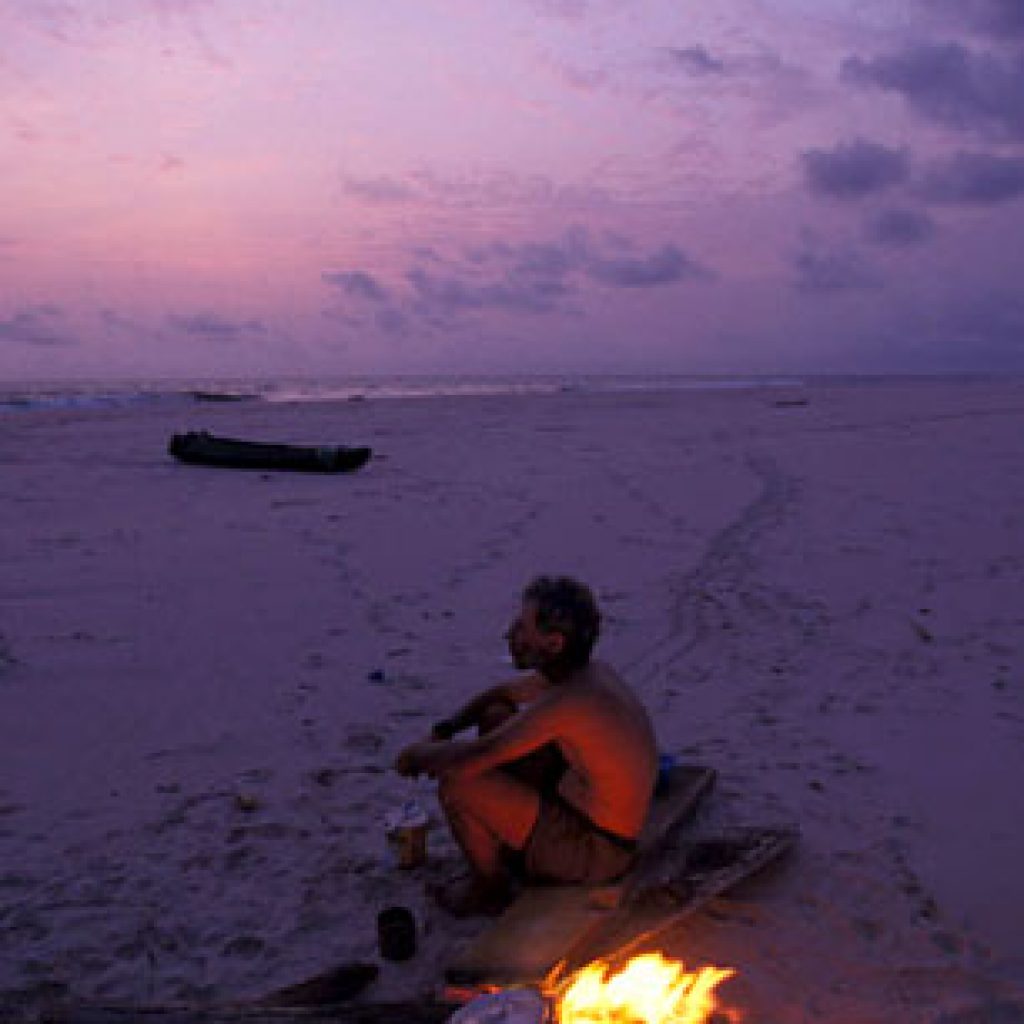
The afternoon was spent luxuriating on the sands of the Atlantic, relishing the ocean breeze and testing ourselves in the kayaks against the sizable ocean surf. If we couldn’t comfortably get off the beach and through the six-foot waves – and then back in – we had some reconsidering to do. The biggest kick of the day was watching some of the locals we met on the beach try the kayaks and get pummeled as they paddled out and back in.
The only disappointment was that 22-year-old Aime was incapable of breaking out through the surf. From the beach I couldn’t tell if it was an issue of not being physically strong enough to power the boat through the series of waves, or if he was just intimidated. Either way, after more than 10 tries without success, the decision was made that he would have to stay behind. Self-sufficiency on the ocean is a requisite; it is definitely not a place for baby-sitting. He’ll paddle to Sette Cama, where his family lives, then fly back to camp out of nearby Gamba. It will be a race to see which of us gets back to the lodge first.
Sitting on a fallen log, our backs to the big beachside baobab, we are paying attention to cooking dinner when a young male elephant wanders out of the forest behind us. Dark-skinned, his ivory tusks yellowed, he sniffs through the grass 20 feet from where we sit. We are upwind, so that he doesn’t catch our scent, intent on his search for a baobab fruit he is convinced is somewhere nearby.
“Holy shit,” says Mike, an unpurposeful imitation of the villager’s reaction to our arrival the other day.
or 20 minutes he moves around the mix of grass-and-sand before shuffling back into the forest. We are camped on the most beautiful of sand beaches at Petit Loango, with signs of animals everywhere. A perfect point-break rolls in front of us and hippos lounge in the lagoon 200 yards down-beach. We can easily make out the flares of oilrigs 35 miles offshore. A pair of trawlers pass by, just two a mile-and-a-half offshore, obviously breaking the three-mile law. With the oil industry in Gabon fading, over fishing has become a new concern.
As the night sky darkens we share only-in-Africa tales. Sophiano is from one of the first villages where Ebola wreaked havoc; of his 11 siblings, eight were killed by the disease, one sister dying in his arms. And it was just a few miles from here where a year-and-a-half earlier Mike had confronted a charging elephant and been gored several times, surviving only by hanging onto its razor-sharp tusks as it slammed him repeatedly into the sand.
But the biggest news in Gabon these days is still the new parks. Thirteen of them are now on the maps, their borders permanently inked. There is no guarantee that they will survive the next generations of leaders in Gabon, but for the moment things look good. But environmentalists working in the country – from the World Wildlife Fund, Conservation International, Wildlife Conservation Society and more — are not resting on their laurels.
“You know what job I’d do for free, in a heartbeat?” Mike asks out loud.
“I’d run a speedboat up and down the coast of West Africa, armed with a bazooka, and take out illegal trawlers. Like those guys out there, fishing inside the limits, and in tandem, which is also illegal. Blam, blam, blam! The word would get out pretty quickly and those suckers would disappear fast, I promise. That’s the kind of thing I wish we could do, right away.”
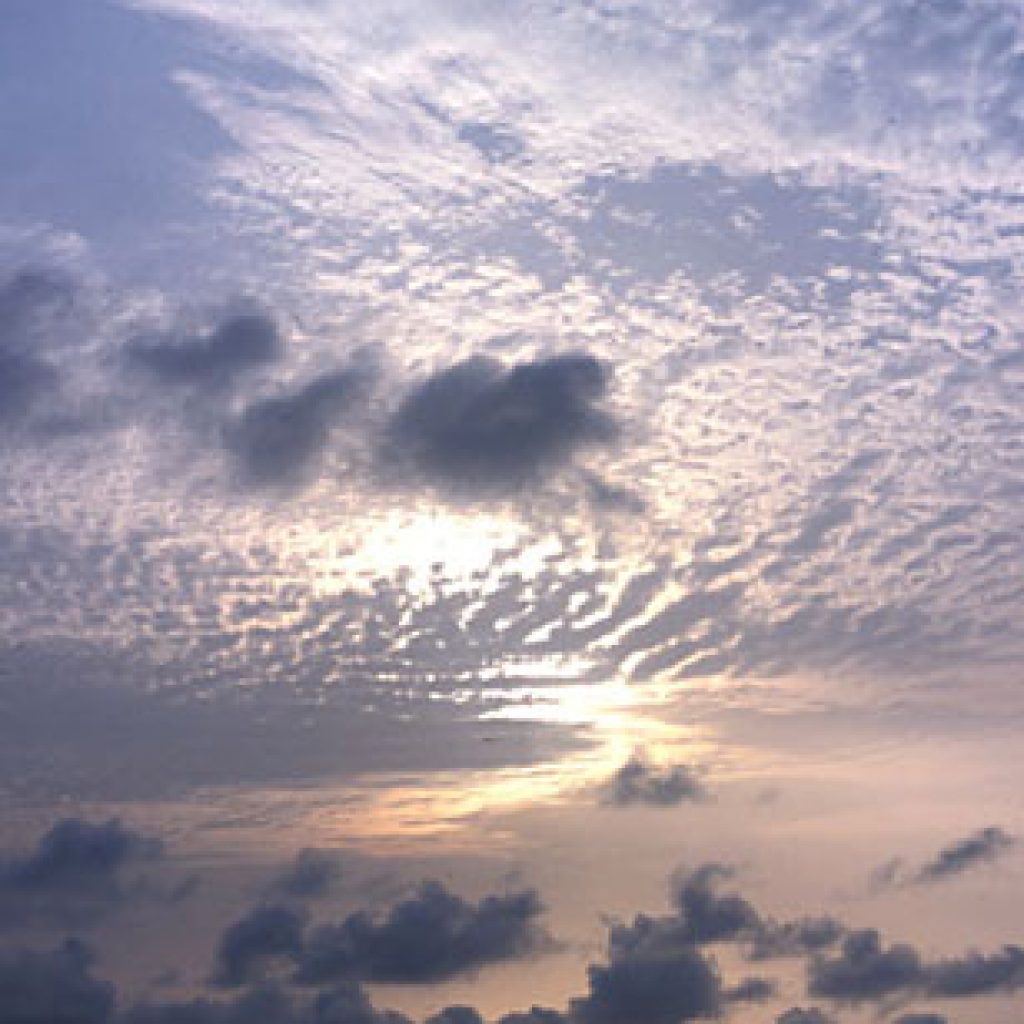
Nearing Pointe Sainte Catherine and the mouth of the Iguela lagoon that will lead us back to the lodge after two weeks of non-stop paddling and pulling, on yet another 100+ degree afternoon, we drag the boats over a low sand-dune to the 15-mile-long Louri Lagoon, paralleling the ocean. Paddling it will give us another perspective on the big animals we’ve been seeing every day along the beach.
And we are not disappointed. Filling dromedaries with tannic brownish water direct from the lagoon and munching on lunch of cashews, jerky, sardines and Clif Bars, we are off, floating quietly down the lagoon. It’s so shallow we must occasionally get out of the boats and pull them over the sandy bottom.
“Let’s try and stick together,” says Mike, “because we’ll probably run into big buffaloes taking baths.”
Sure enough, around the first bend we run smack into an old mom and pop buffalo couple lying in the river, cooling off, attended by a pair of attentive secretary birds picking bugs from their fur. We watch for 20 minutes, just a few feet away, until they stand up and gambol down and across the river.
An hour later we are again bunched up when Mike signals towards the right bank — a big male elephant is pushing its way through the undergrowth towards the river. We hurry our paddling; the light is fading and we are a bit too far away in the dusk light to see him perfectly. Or more appropriately, them, since it turns out to be a whole family.
Two babies and two more adults follow the big male and they walk in a line across the river directly in front of us. Adult, baby, adult, baby, adult, the big ones laying their trunks on the tail of the babies to guide them. We watch under diminishing light, the fact that we’ve been in the kayaks for more than 11 hours this day now a minor complaint.
e end the day just a mile-and-a-half from the outlet back to the ocean; sometime the next day we’ll be back to the lodge, where our greatest desire will be met by several tall glasses of cool, clear water.
The outlet that takes us back out to the ocean is fast flowing, like a Class III river rapid, blue and translucent, offering a fast ride between flat plains of sand. Here we finally meet the ocean conditions I’d anticipated all along – big, rolling seas, marked by 12 and 15 foot rogue waves, requiring full attention. We are two miles off the beach and a flip out here would end in a long swim back to shore.
After a couple hours of easy paddling, just as we are setting up to hit the beach one last time, Mike spies a trawler working just offshore on the other side of the mouth leading back to Iguela. With an eye on the trawler, we ride the surf, landing gently on the beach. Tying straps to the front of the kayaks we pull them through the shallow waters towards the pass, marked by standing waves and strong current, too strong for us to paddle through. Pulling the boats along the edge of the pass, through the fast-moving muddy brown river, thick blocks of sand cascade into the water as we walk gingerly along its edge.
Mike is ahead of me is focused only on the trawler on the other side of the pass. Before I can catch up he’s off, paddling directly across the fast-moving currents rather than hugging the shoreline of the fast-moving river, as we’d planned. At risk of getting sucked out to sea he paddles hard to gain the far side where, armed with satellite phone and video camera, he’s off on foot, to document the trawler fishing illegally and put in a call to someone in the government in the capital city of Libreville to file a report.
Watching his instinctual reaction to environmental abuse, the only thing I can say to Pete is, He’s not packing a bazooka in that kayak . . . Is he??